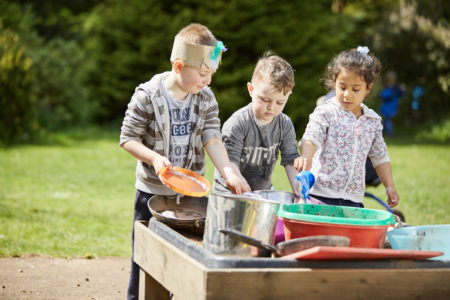A breath of fresh air makes all the difference for our youngest children
Date 4.12.2019
4.12.2019
Dr Tanya Richardson, Senior Lecturer in Early Years at the University of Northampton blogs about the power of getting young children outside to learn.
The impact of the environment on young children’s speech has been something that has interested me for some time now. It stemmed from a time where I owned and managed my own day nursery. The nursery was in a converted warehouse and it had a very small outside area. Because of this tiny outside space, Ofsted refused to grant me any higher than a “good” rating on inspection. We used the local community a great deal, visiting the village horses, going to look for tadpoles in the stream, going to the playground…but still, no matter how much I argued, they would not budge any higher than “good”.
I was determined to get an “outstanding” and therefore I decided to buy a field, as you do. It was a farmer’s field – a complete blank canvas – in that field we set up a forest school. We planted trees and hedgerows, we made interesting areas by importing piles of mud, tyres, planted a maze, and created a fire circle. At the time, I must admit, I really could not see how this was going to give the children any more than we were already providing, but I was determined to get my “outstanding”, so was prepared to play the game.
After using the field for a while, I had to eat humble pie! I could not believe the difference in the children when they were in out forest school. The children came alive when they were at the field. Over the weeks that followed, their confidence grew and I began to notice that they spoke a lot more than when they were inside.
I started to look for research into the effect of the natural environment on speech and language, most instead appeared to mainly be on physical development, creativity and social interactions.
Currently in England, 23% of young children are not at the expected level of speech and language and this can have adverse effects which can last into adulthood. I believe that that the area of speech and language development should be considered a public health problem. The awareness of this as an issue, accompanied with the observation that children seemed to benefit from being in the natural environment that the field provided, therefore started me on the research journey that would lead me to find out more.
I started by recording children’s speech in different environments through the use of body-cameras, I was able to compare the quality of that speech to the quality of the environment, which was assessed by the use of a specially designed rating scale.
Perhaps unsurprisingly, I was able to establish that, there was a connection between the quality of the environment and the quality of speech. Generally, the higher quality the environment was, the higher quality the speech was, but what was surprising, was that the type of environment that produced the highest quality of speech.
The case study settings showed that an outdoor classroom was most conducive to high quality speech and language. I believe that this is due to the nature of the environment, but also due to the fact that practitioners and children are all fairly close by when children are playing. The natural environment was also found to be beneficial for the quality of speech and language, however not so much so as the outdoor classroom, perhaps due to the fact that there is so much space in this environment that interactions between children and those working with them are not so frequent.
I believe that the outdoor classroom should be given as much emphasis as the indoors when considering how we aid children’s speech and language development, worrying when you consider that 85% of practitioners within the UK feel that the outdoor space that they have on offer to children is inadequate and not suited to their developmental needs – this is something that needs addressing as a matter of urgency. To harness the power of these spaces, we should strive for these outdoor classrooms to be more than just an extension of the indoors, with practitioners standing on the periphery, but instead really consider how these spaces are used to maximum benefit for the children within our care.
If we are dealing with a public health issue in the way that speech and language is presenting, then we need to do our upmost to support those children to not just develop but to flourish. It is not enough to give children wings, we have to help them fly!
If you would like any more details of any aspect of this blog, my research, or the University’s Early Years programmes, then please feel free to get in touch – I would love to hear your thoughts!
Dr Tanya Richardson, Senior Lecturer in Early Years at the University of Northampton.